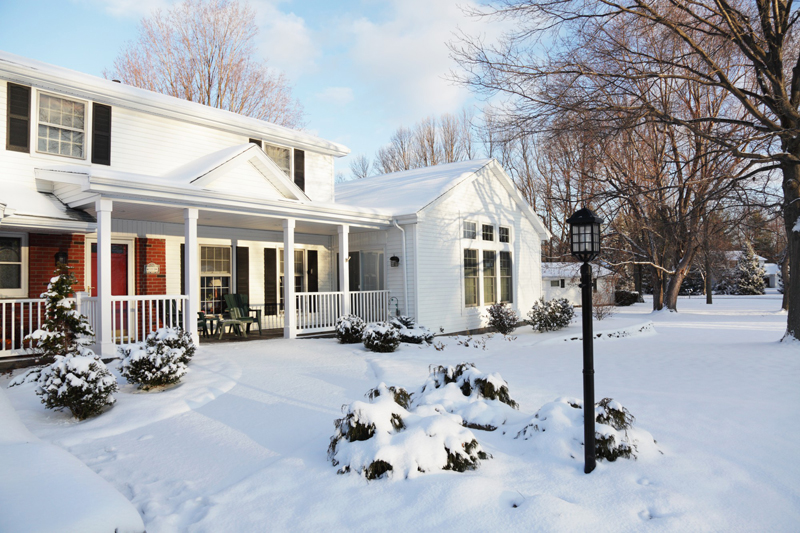Guide to Winter Moves

Moving
during the winter months requires special considerations for a smooth
transition. Keep an eye on the weather forecast to plan your move around
any potential snow or ice storms. Ensure that walkways and driveways
are clear of snow and ice to prevent accidents. Keep winter wear, such
as coats, gloves, and scarves, easily accessible to stay warm during the
move. Protect your floors and carpeting from wet and muddy shoes with
mats or plastic covers. Stock up on winter supplies like salt for
de-icing, shovels, and emergency kits in case of unexpected weather
changes. Lastly, confirm that utilities at your new home are turned on
and functioning properly to ensure a warm and comfortable arrival. By
following these steps, you can ensure a safer move during winter
Planning Ahead: What to do in Advance of Your Move?
●
Your Weather App is Your Friend:
Monitor the weather report for days prior to and the day of your move.
If a storm or other adverse conditions appear in the forecast that could
shut down roads or adversely impact your movers, call your moving
company.
●
Clear the Path:
Know that you are responsible for your driveway and walkways. Make sure
to shovel, clear, and salt all outdoor areas that the movers will need
in order to access your home. Doing this will avoid any additional
delays and fees that could be incurred otherwise.
●
Plan For Your Pets:
Moving can be stressful for you but imagine how your pets feel. Pets
can panic and become stressed to the point of becoming seriously ill or
run through an open door on move day and get hit by a car. We strongly
recommend making arrangements for your pets to stay with friends,
family, or at a pet daycare on the day of your move no matter the time
of year.
●
Ask Friends or Family to Watch the Kids: Children,
especially young children don’t pair well with moving. As the moving
process will likely demand most of your attention on move day, be sure
to secure childcare outside of the home for your children if possible.
The kids will be more comfortable and you will be able to concentrate on
your move.
●
Access Granted: If
you live in a gated community or a neighborhood with an active
homeowners’ association, be sure to check ahead of time that your
community does not have any deed restrictions for moving trucks. Some
communities have policies or by-laws that do not allow moving trucks
direct access.
●
Warm Reception: It’s
cold out there. Make sure that you have electricity and heat turned on
in your new home a couple days ahead of your scheduled move day. This
gives you a cushion in case the utility company is delayed. Unpacking is
tough enough without doing it in a dark, frigid home.
●
Extra Space: If
your street plow sometimes leaves mushy, dirty banks of snow on your
property be prepared ahead of time to shovel the morning of your move or
have parking available that is not directly on the plow route. While
you may have cleared and de-iced paths ahead of time, a big bank of snow
overnight could throw a wrench into you and your movers’ plans.
After Your Move, Hold Off on Handling These Items:
●
Washing Machines: While
the water should have been drained from the pump prior to being loaded
on the truck, washers always have some water still inside the mixer
valve, pump, and hoses. Hold off on operating your washing machine until
all frozen moisture has thawed completely and your appliance is room
temperature to avoid damaging your appliance.
●
Grandfather Clocks:
If grandfather clocks are exposed to extreme cold, pivot points and
other small components will contract and tighten. Do not set your
grandfather clock until all components have reached room temperature to
avoid damaging the clock’s mechanisms.
●
Waterbed Mattresses:
Some moisture inside the mattress may freeze in the cold. To avoid
cracking the vinyl casing, waterbeds should be kept in their boxes and
not handled until at least 12-24 hours have passed since being unloaded
at your destination.
●
Dryers:
Like some of your fragile items, the cold can make igniters and other
dryer components brittle. Avoid operating them until all parts have
reached room temperature to keep your dryer in proper working order.
●
Icemakers: Prior
to being loaded on the truck your icemaker’s solenoid valve should be
drained to reduce excess water and limit freezing. However, residual
moisture may still remain within the valve and may freeze in transit. As
with your other appliances, be sure you let your ice maker get all the
way to room temperature before hooking it up and perform a systems check
before operating it.
●
Water Softener: Water
softening tanks can be negatively affected by freezing of remaining
moisture. Let your tanks warm to room temperature before setting them up
at your new home.
●
Electrical Equipment:
Electricity and water do not mix. Exposing televisions, computers,
stereo systems, and other electronics to extreme temperature changes may
create condensation. Make sure all electronics have warmed to room
temperature before connecting to power.
Moving
in the dead of winter to areas with subzero temperatures is no easy
feat. While being prepared helps both you and your movers when the big
day arrives, no amount of preparation can control the weather. Err on
the side of caution and stay flexible. As stressful as moving can be,
safety should always be you and your movers’ first priority.
Click Download Now to download the guide.